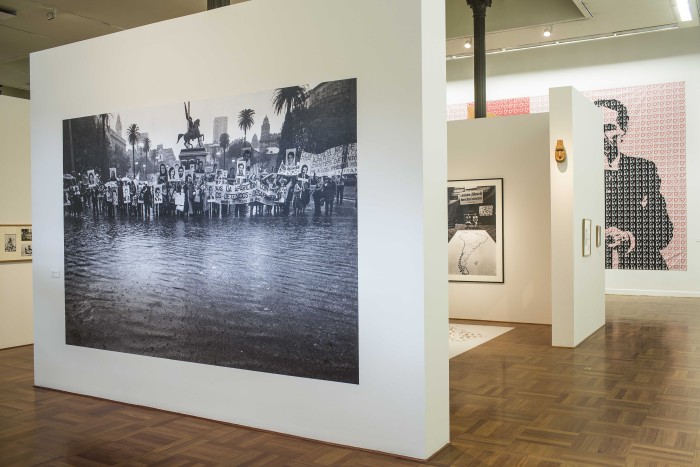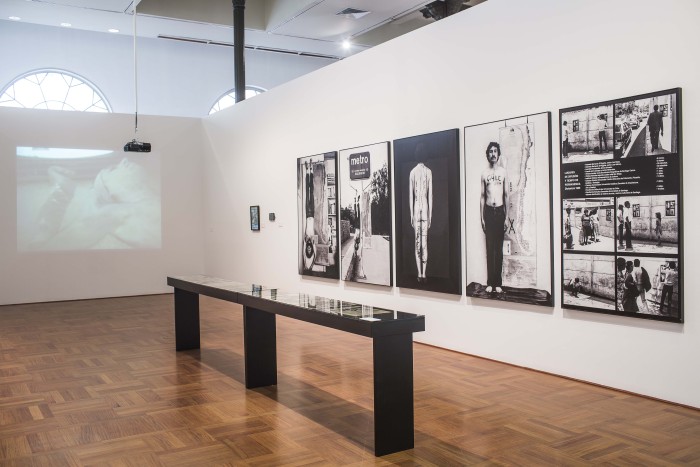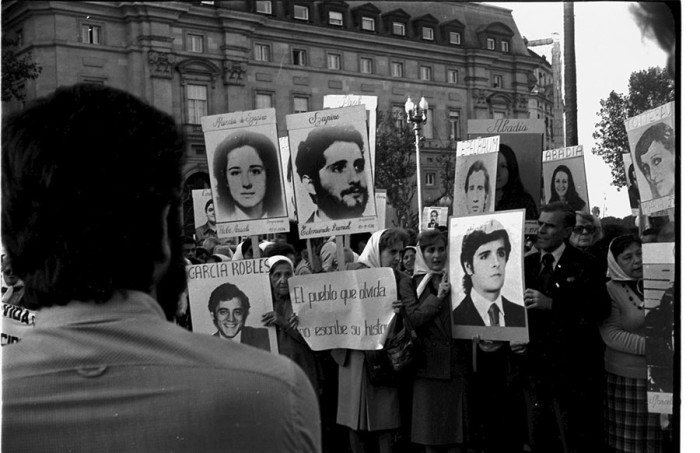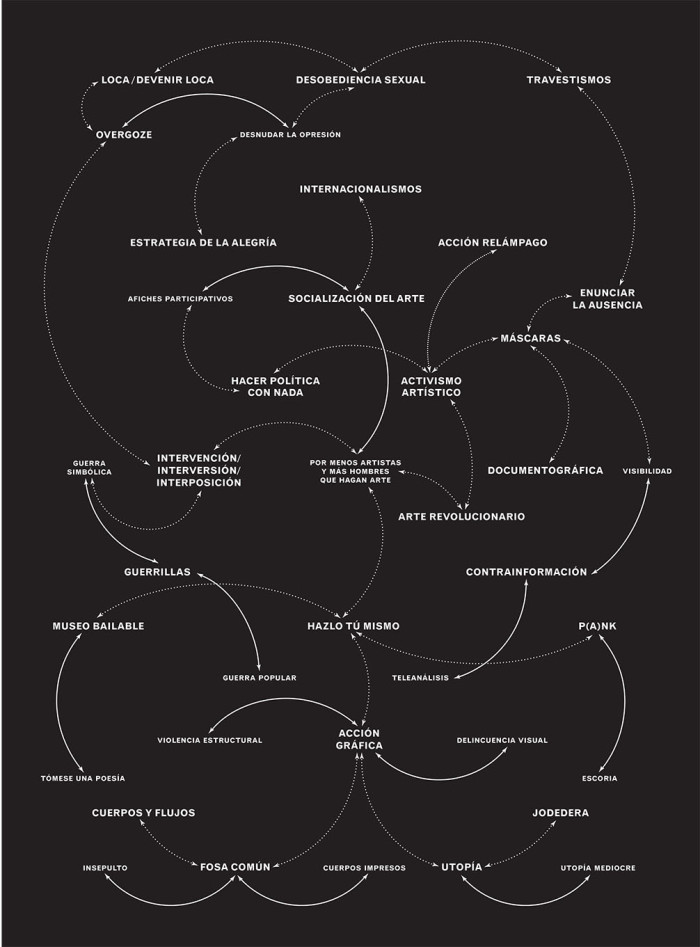
07.12.2015
Fabiola Iza tackles the ambiguities and potentialities of the use of archives in recent exhibitions dealing with alternative histories of art in Latin America: Losing the Human Form: A Seismic Image of the 1980s in Latin America at Museo Reina Sofía in Madrid in 2012 and Arte ≠ Vida: Actions by Artists of the Americas, 1960–2000 at Museo del Barrio in NYC in 2008.

The last fifteen years have seen a surge of interest from large-scale museums and institutions in the art created under the dictatorships that ravaged Latin America throughout the second half of the 20th century. Both inside and outside the region, major exhibitions –along with smaller attempts– have been produced in order to communicate a different narrative of life under such extremely violent contexts. Arte ≠ Vida. Actions by Artists of the Americas 1960-2000 (Museo del Barrio, New York City, 2008) and Losing the human form: A seismic image of Latin America during the 1980s (Museo Nacional Centro de Arte Reina Sofía, Madrid, 2012) are two of the most representative examples and they also share a number of traits. First, both exhibitions were produced outside of Latin America and in countries with which the region has had a particularly troubled relationship: Spain and the United States. Second, the research endeavors undertaken by their respective curators were successful in terms of filling in a gap in the art historical narratives from the region, shying themselves away from previous readings that either highlighted the “fantastic” nature of the subcontinent’s cultural production or addressed it as the periphery that replicates whatever is created in the centre (the West).(1)
The exhibitions offer fruitful examples of the work that different cultural practitioners undertake whilst addressing archives that are bound to a specific historical period; each project brought together an impressive number of artworks, as well as documentation of various artistic events, that are a response to or against the sociopolitical context in which they were created. Arte≠Vida. Actions by Artists of the Americas 1960-2000 was produced at El Museo del Barrio, in New York City and curated by Deborah Cullen, then chief curator of the institution. After its NY debut, the exhibition traveled to large-scale museums in Texas, Mexico City, Puebla, Bogotá, and São Paulo. Framed under the policy of cultural inclusion, El Museo del Barrio’s mission is to welcome ‘visitors of all backgrounds to discover the artistic landscape of Latino, Caribbean, and Latin American cultures’(2), all of which conform the present day US population. As for the curatorial argument, it stressed through the featured works how the human body became the prime material to produce art under the harsh regimes the regions encompassed in ‘the Americas’ suffered. Nevertheless, the title itself reflects the premise on which the whole project was conceived: the representation of violence is not tantamount to actual life under dictatorships. In the broader scheme, the exhibition’s existence is related to the shift in the representation of Latin America and its changing strategies of artistic and cultural production throughout the 1990s. Losing the human form: A seismic image of the 1980s in Latin America, on the other hand, was curated by Red de Conceptualismos del Sur, a loose grouping of scholars, art historians, and theoreticians who hail from different Latin American countries and whose declared mission and academic goal is to halt the dissolution of memory. The research collective has also expressed that their shared purpose is to bring the region’s artistic legacy ‘back to life in the present tense’ through research, exhibitions, publications, and open source databases. Conversely to Arte≠Vida, Losing the human form was not produced under the umbrella of multiculturalism but rather under the de-colonial mission of the Reina Sofía, an institution committed to fostering projects that may also enable a reflection on Spain’s own situation: a country with a colonial past which also finds itself in the aftermath of a dark period, the Franco dictatorship that followed the Civil War. The exhibition’s focus was also the human body, yet it showcased the corporeal not only as a subject of violence, also as a vehicle for emancipation, both sexual and political. The show’s chronological span is narrower, starting in 1973 –when, in Chile, Salvador Allende was overthrown by the militia sponsored by the United States– and ending in 1994 –the year of the Zapatista insurrection in Chiapas, Mexico. It follows an itinerary bound by hallmarks of history told from the left. Both exhibitions were remarkably successful in showing the overlap between practices of art and activism, which quite often merged during the explored timeframes. Thus, each exhibition created its own unique discursive framework: the former organized following a chronological structure but also by different thematic modules and geographical clusters, the latter under the conceptual mapping devising the criterion of affinities and contagion.

A brief overview of some of the works featured in the exhibitions may be familiar to any person familiar with Latin American art from the 20th century: photographs from the Siluetazo in Argentina, Graciela Carnevale’s “lock-up” action in Rosario, documentation of the performances of the Peruvian Grupo Chaclacayo, Lotty Rosenfeld’s Una milla de cruces sobre el pavimento (A Mile of Crosses on the Pavement), CADA’s actions flying over the Chilean snowy mountains, or a naked Tania Bruguera disemboweling a dead animal, among many others. It is particularly relevant to analyze how both exhibitions envisioned or posed questions about the role of the document, how, in the curatorial reprise, each image, object, or film became a testimony, a vessel which granted access to the history it tackles. The past, however, cannot be restored. Even if it is true that those exhibitions create new archives –an act that is in and of itself political whilst it defies the existing national and governmental narratives–, does that suffice to generate a different narrative? Is the task of the curator thus understood as the task to enact an additive model of history?

When it comes to violent histories, facts do not quite add up. Disappearances, repression, torture, corruption, and institutional obscurity face the difficulty of a lack of information leading to a failure of transmission. Paradoxically, the defiance set in the creation of a new archive turns itself into an exercise of power when spectators confront it: little if any space is left for them to participate in the creation of an alternative history. Such projects aim to situate the viewer ‘on the right side of history’, as art historian Claire Bishop has asserted in Radical Museology (although she praises rather than criticize the efforts undertaken at the Reina Sofía, whose purpose is to counter hegemonic narratives)(3). It would be unfair to deny that both Arte≠Vida and Losing the human form seek to respond to the historical specificities and political conditions from which each emerges; yet an archive, any archive, should also be thought of as an agent of history, an entity that speaks about the past but that also performs ‘an effort to create new conditions both for the appearance of things and for our appearance as its narrators, as the ones who can –at any given moment– intervene in the order of things that constituent violence has created as their natural order.'(4)
In spite of acknowledging the paradigmatic role of these exhibitions, the reverberating voice of the archive in them –and its activation– feels somewhat futile. Whilst Arte≠Vida had a more positivist approach to the display of the archive, the curators of Losing the human form intended to create a social space, one where its display might transform social relations through which the archive could relate not only to the past but to current lacks, needs, and the uneasiness that afflicts the present-day cultural and political landscape. From the show’s self-imposed burden, a question arises: is the medium of the exhibition responsible for fulfilling a promise that is, perhaps, too difficult to fulfill? To reactivate documents through their display and to manage to affect the viewer without turning the depicted populations into victims or addressing artistic practices of a highly political character without nostalgia, for example, appears to be a task unlikely to be achieved. This may also be indebted to the formats under which curatorial work is conceived and commissioned in most institutions.

Given that many countries that were ruled by dictatorial governments are now experiencing a relative openness and archives are more likely to be made public and generate new narratives, the issue this piece brings to the fore –is how to perform the archive now– a constant matter of debate. More specifically, in Latin America this question has triggered a dscussion led not only by curators but by artists themselves, and, the most compelling examples are constituted by the dialogue between both kinds of practitioners (it is worthy to mention the joint reflection of Argentine artist Graciela Carnevale and the very own Red de Conceptualismos del Sur).(5) As such, this piece provides two theoretical propositions as tentative approaches to archival exhibitions. I would avow then that it is time to ask for a different kind of acknowledgement (6) to these historical events, that it is up to younger generations of cultural practitioners to embrace the confusion that confronts us. This would include, stripping bare practices associated with current academic conventions in the study of archives (an approach propitiated by institutional demands) and embark upon more radical ways to think about the archive and to undermine the authorities entrenched in the establishment of new narratives.
The first idea that informs my proposition stems from Avery Gordon’s Ghostly Matters(7), a study on haunting as a sociological methodology, in which she asks us to look for the ghosts who inhabit stories such as disappearance or slavery–contexts where histories are written (or unwritten) and social and political systems come into being. Gordon inquires on Argentina during its military dictatorships, focusing on the figure of the desaparecido. Her writing explores the role that photography played –and continues to enact– in the historical memory configuring this complicated moment. She expresses that “you cannot encounter this kind of disappearance as a grand historical fact, as a mass of data adding up to an event, marking itself in straight empty time, settling the ground for a future cleansed of its spirit. In these matters you can only experience a haunting, confirming in such an experience the nature of the thing itself: a disappearance is only real when it is apparitional.”(8) She explains that the Madres de Plaza de Mayo made wide use of photographs, mainly portraits of their loved ones, to create a punctum in public space –it performed a claim as their spectral presence was a poignant reminder of their absence. Going back to the question of imposition of the archival narrative –how can this spectatorial crisis be produced and repeated in an exhibition? Gordon goes on and affirms that ‘The punctum, then, is not simply my individual aesthetic experience; it is what brings to life the life external to the photo’, ‘the medium by which the photograph and its reference come alive.’(9) I do not recur to Gordon’s writing looking for an answer, a formula that may prove itself useful if followed in curatorial practice, but as a way of questioning the document, to ask how it related to others at the moment of its apparition and ponder if that relation could still take place in present time.
The exhibitions’ treatment of photography can be considered a symptom of the overall positioning of the curatorial discourses underpinning both exhibitions. As a medium per se, it is reduced to evidence, given by the documentary nature of a great deal of the displayed images. Nonetheless, as I mentioned above, by culling together both documentary and artistic photographs, the two exhibitions create –either consciously or unconsciously– archives, and this carries all the usual problems that affect these bodies of knowledge. An archive, says Israeli scholar Ariella Azoulay, is one of the ways that photography is disciplined as it assembles produced evidence into a cohesive entity of meaning and is thus ‘an institution and a practice which in their performance essentially resemble other disciplinary sites’.(10)
Elsewhere, Azoulay has asked how images can help reconstruct unrealized possibilities, practices and dreams that motivated and directed the actions of various actors who engaged in transformations of the past –a wink to Walter Benjamin. This is the second idea this essay highlights, that is what Azoulay has named ‘potential histories’. How can we, cultural practitioners and spectators alike, destabilize the ways in which archives are created and question their apparent narration of history? That is, how may we undermine its construction as a fixed succession of events that replicates categories, classifications, and modes of engaging with the world that surrounds us? Together with Gordon, Azoulay suggests that whatever has been repressed by violence remains alive and accessible––through its re-animation. Hence, my proposal is to inquire on methodologies that may animate and potentialize the archival materials used by curatorial projects –perhaps taking inspiration from artists’ projects– in order to problematize rather than to sidestep the difficulties in terms of representing violence and its effects. To look for their potentiality implies letting them resonate in the present, a timely opportunity considering that regardless of the geography, people who express dissent to the ruling systems might find themselves victim to disappearance–archival or otherwise. Hence, events from the past can’t be addressed so simply, because as data continues to add up, historical recognition or canonization might not follow.
Instead of constituting narratives that stand on the correct side of history, could exhibition practice suggest potential histories? If so, the potentiality of history can be a useful tool in order to shed light on the representation of convoluted histories in different regions, Latin America amongst them. Such a task might assist in the process of demonstrating ‘to others the moment in which an open door comes alive and stops us in our tracks, provoking a different kind of encounter and recognition.’(11)
Notes:
(1) For a thorough exploration of ‘the fantastic’ characterization of Latin American art see Gerardo Mosquera, ed., Beyond the Fantastic: contemporary art criticism from Latin America (London: Institute of International Visual Arts, 1995).
(2) Museo del Barrio’s website, retrieved from http://www.elmuseo.org/about-el-museo/ on 06/29/2015.
(3) See Radical Museography: Or, What’s Contemporary in Museums of Contemporary Art? (Cologne: Verlag Koning, 2014), pp. 6, 37–45.
(4) Ariella Azoulay, ‘Potential History’, Critical Inquiry 39 (2013), 565.
(5) The conversations on the current uses and abuses of the archive Carnevale produced, as well as the risks she has taken whilst keeping or destroying it, have been compiled in a book titled DESINVENTARIO. Esquirlas de Tucumán Arde en el Archivo de Graciela Carnevale (2015), authored by the artist herself and Marcelo Expósito, André Mesquita and Jaime Vindel.
(6) Avery Gordon, Ghostly Matters: Haunting and the Sociological Imagination (Minneapolis: University of Minnesota Press, 2008).
(7) Gordon, p. 63.
(8) Gordon, p. 63.
(9) Azoulay, 97.
(10) See Ariella Azoulay, “Archive” in Political Concepts 1 (The New York School of Social Research, 2011), accessed February 11, 2012, http://www.politicalconcepts.org/issue1/archive/
(11) Gordon, 67.
Comments
There are no coments available.